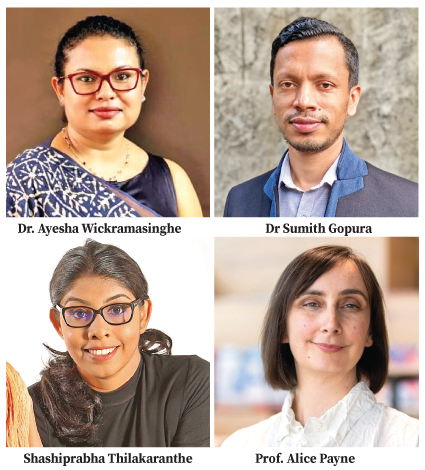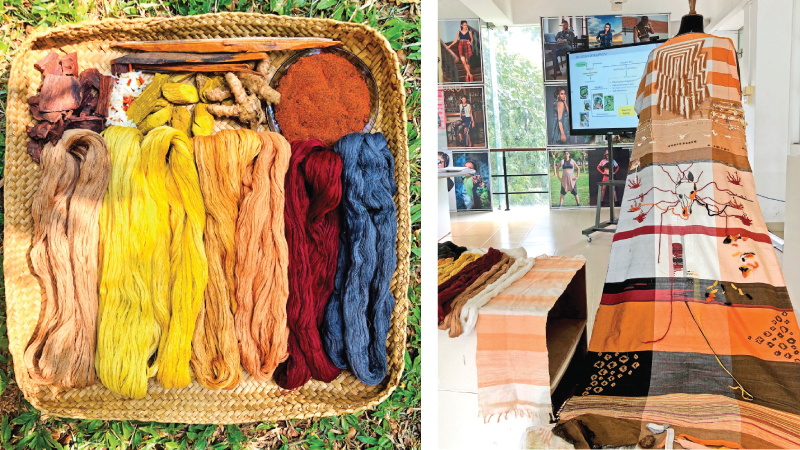Storytelling is as ancient as humanity itself. From prehistoric times, people have shared tales that transcend time and geography, embedding their lived experiences, knowledge, and creativity into narratives that eventually became folklore. These stories, passed down through generations, provide deep insights into the history, geography, and culture of societies, reflecting their values, beliefs, and customs.
A team of fashion experts from the Department of Textile and Apparel Engineering at the University of Moratuwa is now weaving these age-old tales into modern fashion, offering a new way to preserve and celebrate cultural heritage. Led by PhD candidate Shashiprabha Thilakarathna, this research focuses on integrating folklore into fashion, with a special emphasis on the story of Kuweni, a character deeply rooted in Sri Lankan mythology.
Shashiprabha’s study, co-supervised by Dr. Sumith Gopura, Dr. Ayesha Wickramasinghe from the University of Moratuwa, and Professor Alice Payne from RMIT, Australia, is pioneering this creative intersection of culture and fashion.
 Kuweni, the unacknowledged queen who aided King Vijaya in his conquest of Sri Lanka, holds a significant place in the country’s history. Her narrative, which blends mythology, anthropology, and cultural studies, has long inspired the arts, from literature and drama to film and music. However, until now, Kuweni’s story has remained largely unexplored within the fashion field.
Kuweni, the unacknowledged queen who aided King Vijaya in his conquest of Sri Lanka, holds a significant place in the country’s history. Her narrative, which blends mythology, anthropology, and cultural studies, has long inspired the arts, from literature and drama to film and music. However, until now, Kuweni’s story has remained largely unexplored within the fashion field.
Shashiprabha’s research aims to transform this folklore character into a fashion icon. Through what she terms the “Thematic Metaphorical Approach” and “Folklore Characteristics Onion,” she systematically examines the diverse stories and layers of Kuweni’s tale, identifying core themes and characteristics that resonate with her narrative. This approach not only preserves the integrity of the folklore but also offers a framework for creative industries to explore and reinterpret traditional tales without losing their essence.
Endless possibilities
“In my three years of studying folklore, I have discovered endless possibilities, particularly in Kuweni’s story. My research has led me to explore various traditional art forms, such as handloom weaving, eco-friendly textile processing, and natural dyeing and printing,” Shashiprabha said. Her work connects Kuweni’s historical craftsmanship. Kuweni was said to be spinning cotton at the time of King Vijaya’s arrival to Thambapanni. It reconnects with one of the ancient craft sectors of the country – Handloom, offering a unique dialogue between past and present.
Dr. Gopura, an expert in fashion knowledge and cultural flows, contributes by framing these ancient narratives within contemporary fashion contexts, while Dr. Wickramasinghe, with her expertise in the contextual aspects of fashion, ensures that the study maintains a deep connection to Sri Lanka’s heritage. Prof. Payne’s international perspective adds an invaluable dimension, ensuring that the research appeals to a global audience.
The study also aligns with modern fashion movements like “Localism,” which emphasises a strong connection between communities and their local environments.
Localism promotes the responsible production and consumption of locally made products, advocating for environmental sustainability and the preservation of traditional crafts, as Dr. Gopura said. By combining localism with storytelling, Shashiprabha’s work highlights the importance of safeguarding endangered traditions and rituals while integrating them into contemporary fashion.
“The novelty of this study lies in uncovering what has been hidden in society for centuries, preserving intangible cultural heritage,” Dr. Wickramasinghe said. This innovative approach bridges ancient craftsmanship with modern design, fostering a sense of pride in Sri Lankan traditions while making them relevant for today’s fashion industry.
Shashiprabha presented her findings at several international conferences, earning recognition for her contributions to eco-friendly fashion product development.
Her research demonstrates how sustainable practices, such as natural dyeing and responsible textile processing, can globalise local traditions while promoting environmental responsibility, as observed by Prof. Payne, who is also an expert in sustainable fashion.
“Most of my findings are related to developing eco-friendly fashion products,” Shashiprabha said.
“This is key to globalising localism in the modern fashion world. I hope to infuse Sri Lanka’s rich heritage of craftsmanship into modern fashion, creating a dialogue that celebrates our traditions on the global stage.”
Through this groundbreaking research, folklore is no longer just a relic of the past—it is being made fashionable. Shashiprabha’s work serves as an inspiring example of how cultural heritage can be preserved and celebrated in innovative, sustainable ways, ensuring that the stories of the past continue to shape the future of fashion.









